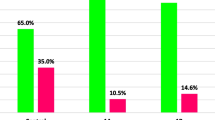Abstract
Purpose
The variability of the recurrent branch (RB) of the median nerve lends itself to an increased risk of injury when performing the minimally invasive approach for carpal tunnel release without its direct visualization. This risk is less so when it is released via the more invasive open approach as the RB can be easily identified, but the drawback is that of longer postoperative patient recovery time. Therefore, performing these releases via the less invasive approach should be more favorable for patients providing it could be done safely. Hence with there being a positive link between the hypertrophy of the thenar musculature and the course of RB according to previous studies.
Methods
We dissected 28 hands of 14 donated bodies fixed using Thiel’s method to try to demonstrate these findings of the associations among the RB, palmar creases and other superficial anatomical landmarks. Fisher’s exact test was conducted to verify the relationship between those structures statistically.
Results
Statistically significant links were found between the type of the RB and the type of the palmar creases (p value = 0.0094) and between the RB type and the palmaris longus muscle presence (p value = 0.028).
Conclusion
It was inferred that palmar creases and other superficial anatomical landmarks listed in the text could not be used to predict the variability of the RB and the choice of mini-invasive approach should not be based on their course.


Similar content being viewed by others
References
Al-Qattan MM (2010) Variations in the course of the thenar motor branch of the median nerve and their relationship to the hypertrophic muscle overlying the transverse carpal ligament. J Hand Surg Am 35A:1820–1824. https://doi.org/10.1016/j.jhsa.2010.08.011
Bennet JB, Crouch CC (1982) Compression syndrome of the recurrent motor branch of the median nerve. J Hand Surg Am 7(4):407–409. https://doi.org/10.1016/s0363-5023(82)80155-x
Green DP, Morgan JP (2010) Correlation between muscle morphology of the transverse carpal ligament and branching pattern of the motor branch of median nerve. J Hand Surg Am 33A:1505–1511. https://doi.org/10.1016/j.jhsa.2008.05.025
Hanna A (2019) Classification of the variants of the palmar recurrent branch of the median nerve with special emphasis on angulation. J Neurosurg 7(5):1–8
Henry BM, Zvinczewska H, Roy J, Vikse J, Ramakrishnan PK, Walocha JA, Tomaszewski KA (2005) The prevalence of anatomical variations of the median nerve in the carpal tunnel: a systematic review and meta-analysis. PLoS ONE. https://doi.org/10.1371/journal.pone.0136477
Hurwitz PJ (1996) Variations in the course of the thenar motor branch of the median nerve. J Hand Surg Br 21B(3):344–346. https://doi.org/10.1016/s0266-7681(05)80198-6
Kaplan E (1965) Functional and surgical anatomy of the hand, 2nd edn. Lippincott Company, Philadelphia and Toronto
Lanz U (1977) Anatomical variations of the median nerve in the carpal tunnel. J Hand Surg Am 2(1):44–53. https://doi.org/10.1016/s0363-5023(77)80009-9
Mannerfelt L, Hybbinette CH (1972) Important anomaly of the thenar motor branch of the median nerve: a clinical and anatomical report. Bull Hosp J Dis 33:15–23
Ozcanli H, Coskun NK, Cengiz M, Oguz N, Sindel M (2010) Definition of a safe-zone in open carpal tunnel surgery: a cadaver study. Surg Radiol Anat 32(3):203–206. https://doi.org/10.1007/s00276-009-0498-7
Park JS, Shin DS, Jung W, Chung MS (2010) Improved analysis of palm creases. Anat Cell Biol 43(169):169–177. https://doi.org/10.5115/acb.2010.43.2.169
Petrover D, Bellity J, Vigan M, Nizard R, Hakime A (2017) Ultrasound imaging of the thenar motor branch of the median nerve: a cadaveric study. Eur Radiol 27(11):4883–4888. https://doi.org/10.1007/s00330-017-4882-0
Pierre-Jerome C, Smitson RD Jr, Shah RK, Moncayo V, Abdelnoor M, Terk MR (2010) MRI of the median nerve and median artery in the carpal tunnel: prevalence of their anatomical variations and clinical significance. Surg Radiol Anat 32(2):315–322. https://doi.org/10.1007/s00276-009-0600-1
Poisel S (1974) Ursprung und Verlauf des R. muscularis des Nervus digitalis palmaris communis I. Chir Praxis 18:471–474
R Core Team (2019) R: A language and environment for statistical computing. R Foundation for Statistical Computing, Vienna
Spinner M (1978) Injuries to the major branches of peripheral nerves of the forearm, 2nd edn. WB Saunders Company, Philadelphia
Tountas CP, Bergman RA (1993) Anatomic variations of the upper extremity, 1st edn. Churchill Livingstone, New York
Tubbs SR, Shoja MM, Loukas ML (2016) Bergman’s comprehensive encyclopedia of human anatomic variations, 1st edn. Wiley, New Jersey
Acknowledgements
We are very thankful to all body donors for their kind donation and Katerina Kuncová for the illustrations used in this text. This research received institutional support from Charles University, Prague, Czech Republic (Grant No. PROGRESS Q37).
Author information
Authors and Affiliations
Contributions
VoK Project development; Dissection; Manuscript writing/editing. MS Photo documentation and its processing; Dissection; Manuscript writing/editing. GF Dissection supervision; Manuscript writing/editing. CN Manuscript writing/editing and data processing. VlK Statistical analysis of data, manuscript writing/editing. DK Manuscript writing/editing and supervision.
Corresponding author
Ethics declarations
Conflict of interest
The authors declare that they have no conflict of interest.
Ethical approval
All procedures performed in studies involving human participants were in accordance with the ethical standards and with 1964 Helsinki declaration and its later amendments or comparable ethical standards.
Additional information
Publisher's Note
Springer Nature remains neutral with regard to jurisdictional claims in published maps and institutional affiliations.
Rights and permissions
About this article
Cite this article
Kunc, V., Štulpa, M., Feigl, G. et al. The superficial anatomical landmarks are not reliable for predicting the recurrent branch of the median nerve. Surg Radiol Anat 42, 939–943 (2020). https://doi.org/10.1007/s00276-020-02475-x
Received:
Accepted:
Published:
Issue Date:
DOI: https://doi.org/10.1007/s00276-020-02475-x




